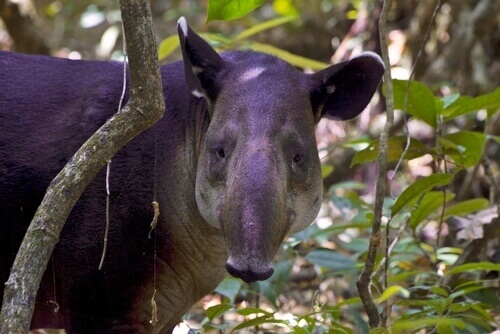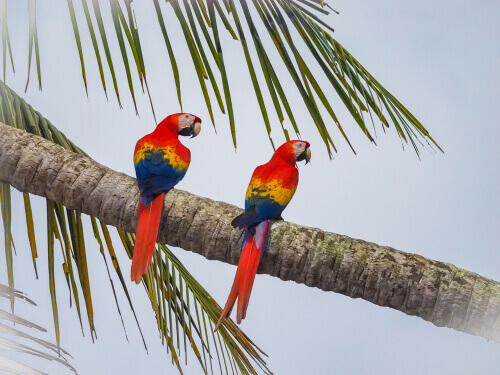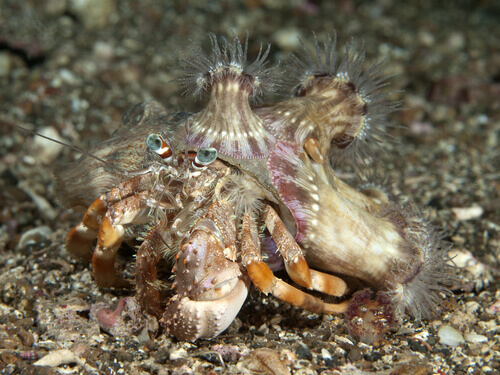Get to Know the Fauna of Corcovado National Park (Costa Rica)

We invite you to explore Corcovado National Park, one of the most biologically diverse parks in Costa Rica. In this wonderful environment of virgin rainforest live a great variety of animals, some in danger of extinction, including birds, mammals, insects, amphibians, and reptiles. It also stands out for its marine fauna.
Some facts about this natural reserve
Created in 1975, the park is located in the Osa Peninsula, in the southwest of this Central American country. It’s about 350 km (220 mi) from San José, the Costa Rican capital. It’s considered a natural laboratory, ideal for studying tropical ecosystems and their relationships.
According to National Geographic, this is the most biologically intense place on the planet. Its 42,560 ha (164 sq mi) of land and 3,354 ha (13 sq mi) of marine areas are home to 2.5% of the planet’s biodiversity.
A landscape of forests, large stretches of uninhabited beaches and thundering waterfalls make Corcovado a natural reserve of undeniable beauty. Regarding its fauna, we can point out that it has about:
- 140 species of mammals
- 400 species of birds, 20 of which are endemic
- 40 species of freshwater fish
- 117 species of amphibians
- 10, 000 types of insects
- 28 species of lizards
Get to know the fauna of the Corcovado National Park in Costa Rica, considered one with the greatest biodiversity on the planet.

The mammals of the Corcovado National Park
If you visit Corcovado National Park, you’ll find the four species of monkeys that exist in Costa Rica, most of them at risk of extinction due to deforestation and poaching. These are the following:
- Golden-mantled howling monkey
- Panamanian white-faced capuchin (photo above)
- Black-handed spider monkey
- Common squirrel monkey
In addition, here we find five of the six wild felines that live in the country:
- Ocelot
- Oncilla or tiger cat
- Jaguarundi
- Cougar
Other mammals in the reserve
This reserve is home to almost all of the few Baird’s tapirs —also known as the Central American tapir (photo below)— remaining in Costa Rica. There are also specimens of peccaries or skunk pigs, which are in danger of extinction due to habitat degradation and poaching.

The reserve is also home to three-toed sloths and coatis, which are among the most numerous mammals in the country. The latter resemble raccoons and have a thin, ringed tail and an elongated nose.
The reserve is also home to:
- Deer
- Agoutis, a genus of rodents
- Anteaters
- River otters
- Bats
Birds of Corcovado National Park
Scarlet macaws (photo below), victims of poaching, can be seen in this magnificent reserve. In this natural park, we can also find an important variety of estuaries. Moreover, the Corcovado Lagoon hosts a great variety of herons, including the boat-billed heron.

The harpy eagle, which was thought to be extinct in the area, and the king vulture, a species of American vulture, can also be seen. And let’s not forget the 16 species of hummingbirds.
Other birds that live in the park include:
- Mantled hawk
- Northern jacana
- Crested guan
- Great tinamou
- Pale-vented pigeon
- Green-billed toucan
Reptiles, amphibians and insects
Reptiles and amphibians are also numerous in Corcovado. There are 40 species of frogs, among them the red-eyed treefrog, glass frog, and poison dart frogs or poison arrow frogs. In the lake and estuaries of the park, however, crocodiles and caimans prevail.

Among the snakes, we can find the boa constrictor, the fer-de-lance, and the Southern American bushmaster —also called Atlantic bushmaster. Speaking of iguanas, we can see the black spiny-tailed iguana (photo above), which looks like a small dinosaur with the ability to glide through water.
There’s also an abundance of spiders with their webs of various shapes. Also, out of the great variety of insects that the park houses, we can highlight:
- 100 species of butterflies
- Leafcutter ants, which are remarkable for the paths they create carrying pieces of leaves
- Legionary ants, the voracious hunters made famous by the movie The Naked Jungle
- Cicadas, which will deafen you with their song
Marine fauna of Corcovado National Park
It’s also worth mentioning the marine fauna of this place. On the beaches of Corcovado National Park, there are the nesting sites of four species of turtle:
- Hawksbill sea turtle
- Olive Ridley sea turtle or Pacific Ridley sea turtle
- Green sea turtle
- Leatherback sea turtle

Additionally, on the rocky coasts, there are large numbers of sea snails and crabs, such as red crabs and hermit crabs (photo above). Also, the sea is inhabited by sharks such as the bull shark and some species of dolphins. Finally, Golfo Dulce (east of the park) is a breeding area for humpback whales.
We invite you to explore Corcovado National Park, one of the most biologically diverse parks in Costa Rica. In this wonderful environment of virgin rainforest live a great variety of animals, some in danger of extinction, including birds, mammals, insects, amphibians, and reptiles. It also stands out for its marine fauna.
Some facts about this natural reserve
Created in 1975, the park is located in the Osa Peninsula, in the southwest of this Central American country. It’s about 350 km (220 mi) from San José, the Costa Rican capital. It’s considered a natural laboratory, ideal for studying tropical ecosystems and their relationships.
According to National Geographic, this is the most biologically intense place on the planet. Its 42,560 ha (164 sq mi) of land and 3,354 ha (13 sq mi) of marine areas are home to 2.5% of the planet’s biodiversity.
A landscape of forests, large stretches of uninhabited beaches and thundering waterfalls make Corcovado a natural reserve of undeniable beauty. Regarding its fauna, we can point out that it has about:
- 140 species of mammals
- 400 species of birds, 20 of which are endemic
- 40 species of freshwater fish
- 117 species of amphibians
- 10, 000 types of insects
- 28 species of lizards
Get to know the fauna of the Corcovado National Park in Costa Rica, considered one with the greatest biodiversity on the planet.

The mammals of the Corcovado National Park
If you visit Corcovado National Park, you’ll find the four species of monkeys that exist in Costa Rica, most of them at risk of extinction due to deforestation and poaching. These are the following:
- Golden-mantled howling monkey
- Panamanian white-faced capuchin (photo above)
- Black-handed spider monkey
- Common squirrel monkey
In addition, here we find five of the six wild felines that live in the country:
- Ocelot
- Oncilla or tiger cat
- Jaguarundi
- Cougar
Other mammals in the reserve
This reserve is home to almost all of the few Baird’s tapirs —also known as the Central American tapir (photo below)— remaining in Costa Rica. There are also specimens of peccaries or skunk pigs, which are in danger of extinction due to habitat degradation and poaching.

The reserve is also home to three-toed sloths and coatis, which are among the most numerous mammals in the country. The latter resemble raccoons and have a thin, ringed tail and an elongated nose.
The reserve is also home to:
- Deer
- Agoutis, a genus of rodents
- Anteaters
- River otters
- Bats
Birds of Corcovado National Park
Scarlet macaws (photo below), victims of poaching, can be seen in this magnificent reserve. In this natural park, we can also find an important variety of estuaries. Moreover, the Corcovado Lagoon hosts a great variety of herons, including the boat-billed heron.

The harpy eagle, which was thought to be extinct in the area, and the king vulture, a species of American vulture, can also be seen. And let’s not forget the 16 species of hummingbirds.
Other birds that live in the park include:
- Mantled hawk
- Northern jacana
- Crested guan
- Great tinamou
- Pale-vented pigeon
- Green-billed toucan
Reptiles, amphibians and insects
Reptiles and amphibians are also numerous in Corcovado. There are 40 species of frogs, among them the red-eyed treefrog, glass frog, and poison dart frogs or poison arrow frogs. In the lake and estuaries of the park, however, crocodiles and caimans prevail.

Among the snakes, we can find the boa constrictor, the fer-de-lance, and the Southern American bushmaster —also called Atlantic bushmaster. Speaking of iguanas, we can see the black spiny-tailed iguana (photo above), which looks like a small dinosaur with the ability to glide through water.
There’s also an abundance of spiders with their webs of various shapes. Also, out of the great variety of insects that the park houses, we can highlight:
- 100 species of butterflies
- Leafcutter ants, which are remarkable for the paths they create carrying pieces of leaves
- Legionary ants, the voracious hunters made famous by the movie The Naked Jungle
- Cicadas, which will deafen you with their song
Marine fauna of Corcovado National Park
It’s also worth mentioning the marine fauna of this place. On the beaches of Corcovado National Park, there are the nesting sites of four species of turtle:
- Hawksbill sea turtle
- Olive Ridley sea turtle or Pacific Ridley sea turtle
- Green sea turtle
- Leatherback sea turtle

Additionally, on the rocky coasts, there are large numbers of sea snails and crabs, such as red crabs and hermit crabs (photo above). Also, the sea is inhabited by sharks such as the bull shark and some species of dolphins. Finally, Golfo Dulce (east of the park) is a breeding area for humpback whales.
This text is provided for informational purposes only and does not replace consultation with a professional. If in doubt, consult your specialist.








